Six weeks ago, we asked you to show us your best 3D printed repairs for a chance to win $100 in Tindie credit and other prizes. You answered the call with fixes for everything from the stuff everyone has, like zippers and remotes, to the more obscure stuff, like amazing microscopes scavenged from dumpsters.
It was hard to whittle down the entries we received into the top 20 because you came up with so many awesome fixes. A few of them had us thinking hard about the definition of repair, but are brilliant in their own way.
So without further ado, we are pleased to announce the winners of our Repairs You Can Print contest. We also want to give honorable mention to those projects that wowed us with ingenuity.
The Top Three Winning Entries
Here are the highest-ranked entries chosen from the twenty winners. Each of these repair projects came with considerable design hurdles, but each of their engineers persevered and came out smelling like a rose (made of melted plastic, of course).
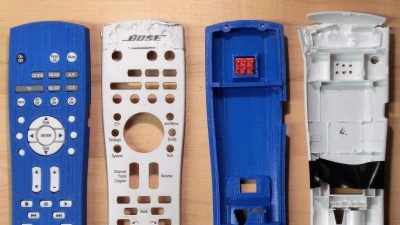 First Place: Fixing a Chewed-Up Remote
First Place: Fixing a Chewed-Up Remote
When [Alex Rich]’s dog chewed up his $90 home theater remote a few years back, he saw an opportunity to more than just replace the case. Any time the furnace or A/C kicks on in his house, it’s just noisy enough to warrant turning up the volume a little bit. Of course, once it shuts back off, then the volume is too loud.
[Alex] had just enough leeway in the new design—and space inside the case—to add a Trinket that communicates with his thermostat and adjusts the volume accordingly. He also hid a hardware power switch on the underside of the remote to prolong battery life. Not only does he have an improved and working remote, he has an interesting conversation piece for the coffee table.
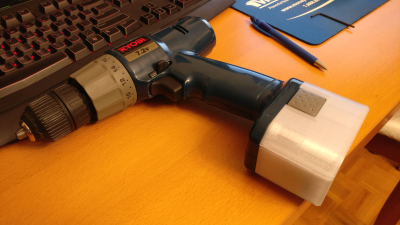 Second Place: Replacement Drill Battery Pack
Second Place: Replacement Drill Battery Pack
Sometimes it seems that planned obsolescence knows no boundaries. Manufactures will move on to the next design or the newest battery composition without a second thought, except the one where they get to force their way back into consumers’ wallets.
[Larry G] wasn’t going to play that game when it came to his old Ryobi drill. He figured that as long as he could approximate the shape of the old pack and get the connections right, he could replace the NiCad pack with commonly-available rechargeable Ni-MH cells. The new pack is wired such that it only supports the max speed, but [Larry] may revisit the project and try to add PWM speed control with a 555.
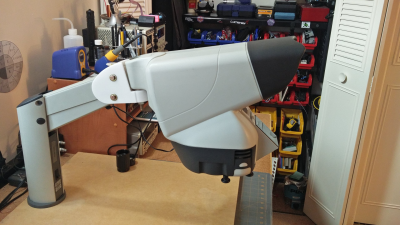 Third Place: Microscope Mounting Bracket Repair
Third Place: Microscope Mounting Bracket Repair
What’s the best thing you ever found while dumpster diving? [leumasyerrp] snagged a $1500 Vision Engineering Mantis Microscope that had been thrown out, presumably because the mounting bracket splintered into pieces and made it unusable.
He printed a new bracket in PLA and attached it with bolts and nylon lock nuts. So far, it holds up the heavy microscope really well. The tricky part was trying fasten it so that the microscope has enough play to pivot, but not so much that it droops after being positioned.
20 Winners of $100 Tindie Credit
This is the complete list of 20 hackers who have been awarded $100 in Tindie credit in recognition of their awesome efforts to fix their stuff. You can browse all the contest entries here.
- 3D Printed Zipper Box
- 3D printed belt for Phillips CD-i
- 3D printed universal cable fix
- Barrel Chair Bearing Repair
- Chewed up remote repair
- Corvair replacement parts
- Customizable Portaholder for Baratza Vario
- Hololens Headband Repair Kit
- MANTIS MICROSCOPE REPAIR
- NLA: DeWalt DW708 Mitre Saw “Dust Extactor”
- Nexus 7 2013 Sim Card Tray
- Ninja Blender Black to Gray Adapter
- PRSOUC35K glue gun revival (3D printed part)
- Printing Molds for Rubber Repairs
- Repairing a tool wall organiser
- Repairing my toolbox with a 3D printed part
- Replacement Battery for Ryobi 7.2v Drill
- Replacing a Disintegrated Rinse Aid Dispenser Lid
- Solder Sucker Repair
- Trigger Keys for MSX Computer
The Special Prize Winners
And now, the moment you’ve all been waiting for.
At the start of this contest, we offered a special prize to the best student-made repair and another to the best fix from an organization. These two winners have each been awarded a Prusa i3 Mk3 with the multi-material upgrade, which lets it print with up to four colors or materials at once without manual reloading.
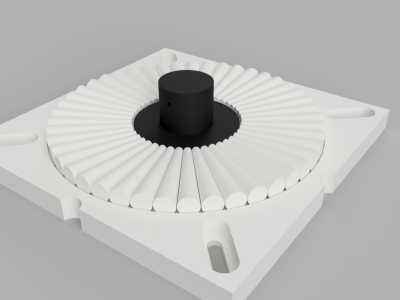 Best Student Entry: Barrel Chair Bearing Repair
Best Student Entry: Barrel Chair Bearing Repair
Our best student entry used the power of extruded plastic to re-invent the bearing and save a swiveling barrel chair.
Years ago, [Matt]’s parents found a comfy swiveling chair that didn’t turn anymore. Since the bearing was riveted shut, he couldn’t just clean out the crud and repack it. He had to rebuild it.
If you’ve never played with a printed ball bearing, they’re usually rough enough to be non-functional. [Matt] designed around the constraints of printing and came up with what we can only describe as a flat tapered roller bearing.
The rollers are tapered cones designed to roll at the same rate at both ends. [Matt] made a 70mm-diameter proof of concept bearing first. It moved really well, so he scaled it up to fit the chair. The new bearing withstood weight just fine, but swiveling made the center post tear away from the bearing. He printed a replacement in TPU, and it’s been smooth swiveling ever since.
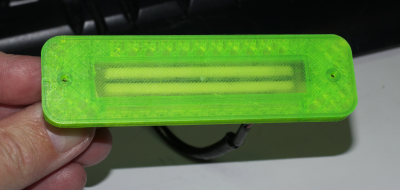 Best Organization Entry: 3D Printed Prius Hatch Release Switch Cover
Best Organization Entry: 3D Printed Prius Hatch Release Switch Cover
Our best entry from an organization used some fused deposition modeling to re-engineer a mistake that’s baked into the Toyota Prius.
[Mark] had a problem with his Prius. The hatch release mechanism has this soft rubber cover that gets gooey in the summer and becomes too stiff to work properly in the winter.
He asked his friends at Milwaukee Makerspace for help, and they designed a replacement cover, printed it in TPU, and sealed it with silicone to keep water out. It’s worked well for over a year and flexes in any weather, even below 0°F/-17°C.
The Honorable Mentions
We had many, many entries that weren’t actually repairs: nothing was broken before it was fixed. But some of these were so cool that we thought we’d give them a shout-out.
[Andrew] needed a variable-speed pump, but all he had lying around was a 3/4 HP fixed-speed pump from Harbor Freight. He bought a BLDC motor and Frankensteined it to the pump by printing an adapter flange, an axial fan to cool the new motor, and a housing to marry it to the pump. How does she chooch? 850 GPH at max speed!
[Ben]’s engineering teacher came to him with an interesting assignment: build a prosthetic for [Grey], a puppy born with a short leg that his teacher met at his own puppy’s obedience school. [Ben] came up with a 20-piece adjustable prosthetic that works with the puppy’s elbow joint. It’s 100% parametric, so [Grey] can scamper into adulthood on an even keel.
[Nelson] was tired of killing vacuum cleaners with filter-clogging fine particulates, so he designed and printed a 7-vortex cyclonic extractor to collect the particles before they can reach the filter. Thanks to the power of physics, he’s going to save about $100 a year and a whole lot of time.
Amazing Entries
A 3D printer is the ultimate design tool for one-off fabrication, and when it comes to repairing bits of broken plastic in our lives, there’s no better option than a 3D CNC hot glue gun.
It was exceptionally hard to decide on the winning entries for the Repairs You Can Print contest, and we wish we could award everyone a prize. The work that came out of the Hackaday community went above and beyond, and we were amazed by what we saw. Thank you to all that entered, and to anyone who chooses to repair their bits and bobs of consumer electronics instead of throwing them away.



















So many excellent entries into this contest, the community really answered the call on this one. It was great to see so many replacement parts and fixes that, to me, are the quintessential 3D printed fix:
1. Original part no longer available
2. Design/print replacement part
3. Release STL (and ideally source) for design to help others
Amazing to see how many “obsolete” pieces of hardware were revived with a pair of calipers and some PLA.
Wow huge honor, thanks! That roller bearing project is amazing.
Side Note: The Prusa i3 MK3 is such a great prize for this contest for the student/org. Not only is it an awesome printer (I have one and love it so far) but it is made of super nice 3d printed parts that are a constant reminder that you can make real functional stuff with a 3d printer.
I’m toying with the thought of buying a 3D printer, it is nice to read your recommendation.
do it, the prusa dual extrude unit is a amazing buy and since I got mine i’ve fixed so many things on my car. btw we live in africa where parts are non existent and oem is a dirty word
The Prusa i3 mk3 is highly recommended by anyone who has one, and for good reason.
I’ve got a Prusa i3 MK3 too, they have a nice supportive community.. plus they’re easy to modify when you’re more confident.
As for adding PWM to the drill with just a 555, you would be in good company there.
When I tore down my completely worn out Milwaukee cordless drill for parts, lo and behold a surface mount version of the 555 was tasked with driving the PWM. Tracing the circuit, they used the novel diode bridged vibrator version for full range PWM instead of the reference circuit, but still.. it was a 555.
Are you related to Erik from North Dakota?
Still, odd in this case that the PWM control was in the battery pack!? I just can’t think why they’d do that.
Well, with things like power banks, nearly all of them use the same mosfets for both output regulation and charge control. Ran into that one trying to adapt a powerbank into a UPS of sorts for a Pi project.
For a drill battery, it would barely make sense as the connectors are probably just as expensive as that one mosfet, but that is one reason. Engineers…
Same here with my DeWalt impact driver, 555 for PWM driving a big TO220 mosfet of some sort.
I went on to use the 555 chip from the old trigger assembly to make a timer to turn halogen lights on and off as an automated test load for my generator.
https://www.youtube.com/watch?v=1fmCMX4JK4UHh
Soooo….
the top 3 winners got the $100 gift card, just like the other 17?
Not true! The top three winners got a Mantis scope, a drill, and a working remote!
…yeah, they each got the $100 gift card…
I thought so, but I didn’t see that mentioned in the article.
And they got written up really nicely in this article!
The truth is that the top 30 (or 40?) in this contest were all really great, and it was very hard to draw the cutoff line. The rules said 20, so we’re stuck with a top 20. It was very difficult judging because of such uniformly good work.
You all rock!
Oh man, how did I miss this one:
I make STL copies of Audi NLA parts like shifter bushing and release them on Thingverse. :(
I don’t know if it will repeat next year, but I hope so!
Seems like it was a big success, so maybe they will. Seems like usually the contests are single-run kind of things, but perhaps this could be done annually?
I kinda disagree with the order of the winners. I personally think the drill battery pack is a MUCH more useful (and cost saving) replacement than the remote that can be sourced on eBay for <$20. Drill batteries are a HUGE racket.
But drill pack looks much easier to design and make.
Thanks for the nice words :) The remote repair is really cool. Finding the dimension like that was really clever!